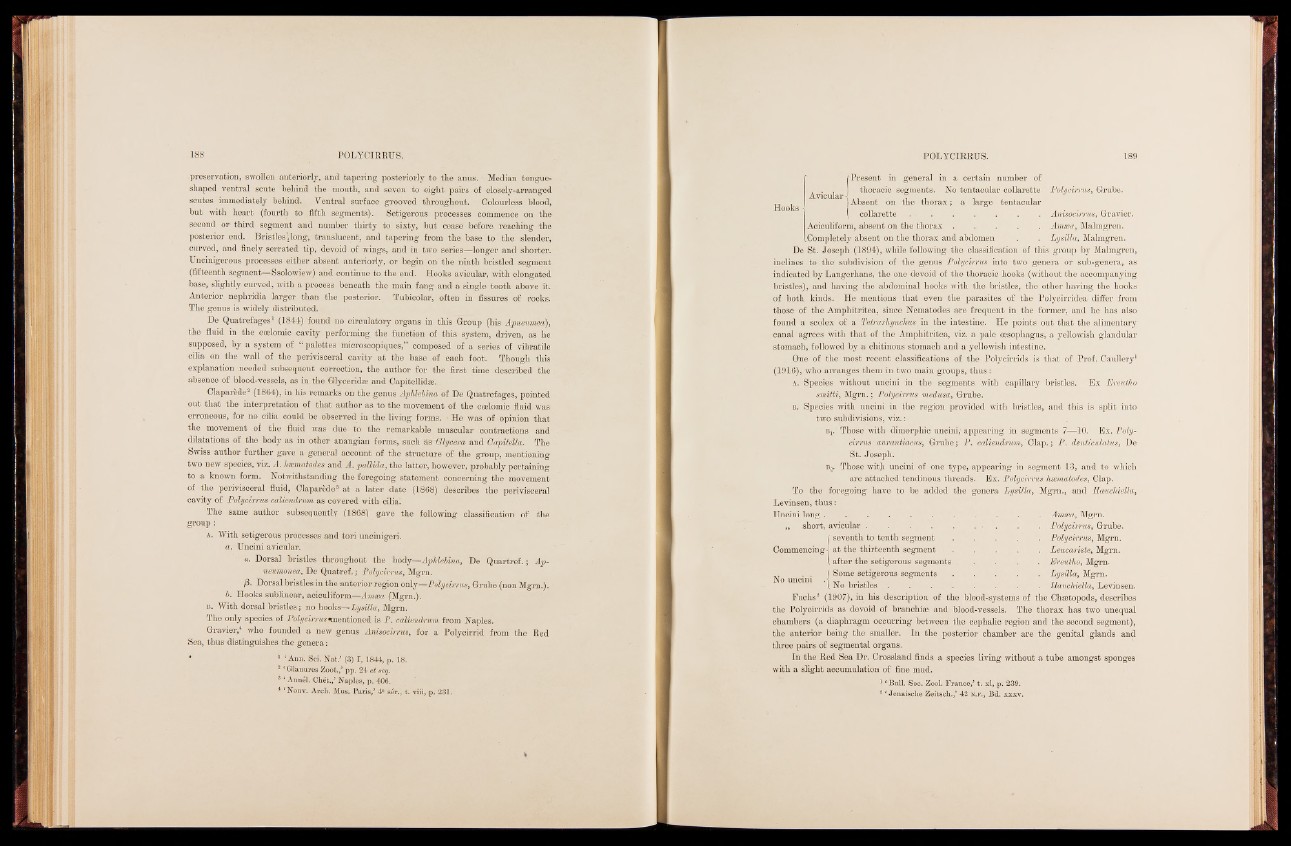
-preservation, swollen anteriorly, and tapering posteriorly to the anus. Median tongueshaped
ventral scute behind the mouth, and seven to eight pairs of closely-arranged
scutes immediately behind. Ventral surface grooved throughout. Colourless blood,
but with heart (fourth to fifth segments). Setigerous processes commence on the
second or third segment and number thirty to sixty, but cease before reaching the
posterior end. Bristles ilong, translucent, and tapering from the base to the slender,
curved, and finely serrated tip, devoid of wings, and in two series—longer and shorter.
Uncinigerous processes either absent anteriorly, or begin on the ninth bristled segment
(fifteenth segment—Ssolowiew) and continue to the end. Hooks avicular, with elongated
base, slightly curved, with a process beneath the main fang and a single tooth above it.
Anterior nephridia larger than the posterior. Tubicolar, often in fissures of rocks.
The genus is widely distributed.
He Quatrefages1 (1844) found no circulatory organs in this Group (his Apneumea),
the fluid in the ccelomic cavity performing the function of this system, driven, as he
supposed, by a system of “ palettes microscopiques,” composed of a series of vibratile
cilia on the wall of the perivisceral cavity at the base of each foot. Though this
explanation needed subsequent correction, the author for the first time described the
absence of blood-vessels, as in the Glyceridæ and Capitellidæ.
Claparede2 (1864), in his remarks on the genus Aphlebina of De Quatrefages, pointed
out that the interpretation of that author as to the movement of the coelomic fluid was
erroneous, for no cilia could be observed in the living forms. • He was of opinion that
the movement of the fluid was due to the remarkable muscular contractions and
dilatations of the body as in other anangian forms, such as~Glycera and CapiteUa. The
Swiss author further gave a general account of the structure of the group, mentioning
two new species, viz. A. hæmatodes and A. pallida, the latter, however, probably pertaining
to a known form. Notwithstanding’the foregoing statement concerning the movement
of the perivisceral fluid, Claparède8 at a later date (1868) describes the perivisceral
cavity of Polycirrus caliend't'um as Covered with cilia!
The same author subsequently (1868) gave the following classification of the
group :
a. With setigerous processes and tori uncinigeri.
a. Uncini avicular.
a. Dorsal bristles throughout the body—Aphlebina, De Quartref. \ Ap-
neumonea, De Quatref. ; Polypvrrus, Mgrn.
(3. Dorsal bristles in the anterior region only—Polycirrus, Grrube (non Mgrn.).
b. Hooks sublinear, aciculiform—Amæa (Mgrn.).
n. With dorsal bristles ; no hooks—Lysilla, Mgrn.
The only species of Polycirrus «mentioned is P. caliendrum from Naples.
Gravier,4 who founded a new genus Anisocirrus, for a Polycirrid from the Red
Sea, thus distinguishes the genera :
' 1 ‘ Ann. Sci. Nat/ (3) I, 1844, p. 18.
3 * Glanures Zoot./ pp. 24 et seq.
8 £ Annél. Chet./ Naples, p. 406.
4 ‘Nouv. Arch. Mus. Paris,5 4e sér., t. viii, p. 231.
(Present in général in a certain number of
Avicular -
thoracic segments. No tentacular collarette Polycirrus, Grube.
| Absent on the thorax ; a large tentacular
I collarette . . . . . . . Anisocirrus, Gravier. Aciculiform, absent on the thorax . . . . . Amæa, Malmgren.
Hooks ^
Completely absent on the thorax and abdomen . . Lysilla, Malmgren.
De St. Joseph (1894), while following the classification of this group by Malmgren,
inclines to the subdivision of the genus Polycirrus into two genera or sub-genera, as
indicated by Langerhans, the one devoid of the thoracic hooks (without the accompanying
bristles), and having the abdominal hooks with the bristles,, the other having the hooks
of both kinds. He mentions that even the parasites of the Polycirridea differ from
those of the Amphitritea, since Nematodes are frequent in the former, and he has also
found a scolex of a Tetrarhynchus in the intestine. He points out that the alimentary
canal agrees with that of the Amphitritea, viz. a pale oesophagus, a yellowish glandular
stomach, followed by a chitinous stomach and a yellowish intestine.
, One of the most recent classifications of the Polycirrids is that of Prof. Caullery1
(1916), who arranges them in two main groups, thus :
a. Species without uncini in the segments with capillary bristles. Ex Ereutho
smitti, Mgrn. ; Polycirrus medusa, Grube.
b. Species with uncini in the region provided with bristles, and this is split into
two subdivisions, viz. :
Bj. Those with dimorphic uncini,- appearing in segments 7—10. Ex. Polycirrus
aurantiacus, Grube ; P. caliendrum, ' Clap. ; P. denticulatus, De
St, Joseph.
b2. Those with uncini of one type, appearing in segment 18, and to which
are attached tendinous threads. Ex. Polycir'rus hæmatodes, Clap.
To the foregoing have to be added the genera Lysilla, Mgrn., and Hauchiella,
Levinsen, thus :
Uncini long . . . . . . . . . . . Amæa, Mgrn.
No uncini
Polycirrus, G-rube.
Polycirrus, Mgrn.
Leucariste, Mgrn.
Ereutho, Mgrn.
Lysilla, Mgrn.
Hauchiella, Levinsen.
,, short, avicular . . .
( seventh to tenth segment
Commencing j at the thirteenth segment
1 after the setigerous segments
( Some setigerous segments
1 No bristles . . . .
Fuchs2 (1907), in his description of the blood-systems of the Chgetopods, describes
the Polycirrids as devoid of branchiae and blood-vessels. The thorax has two unequal
chambers (a diaphragm occurring between the cephalic region and the second segment),
the anterior being the smaller. In the posterior chamber are the genital glands and
three pairs of segmental organs.
In the Red Sea Dr. Crossland finds a species living without a tube amongst sponges
with a slight accumulation of fine mud.
1 f Bull. Soc. Zool. France,51. xl, p. 239.
3 ‘ Jenaische Zeitsch.,5 42 n.f., Bd. xxx'v.